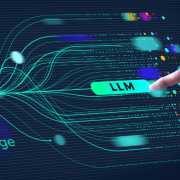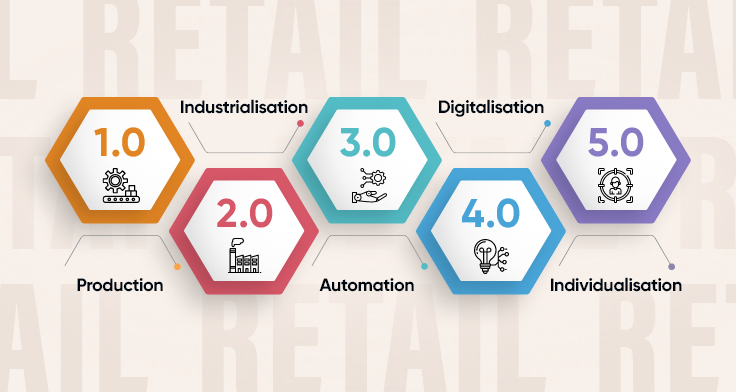The retail industry has undergone remarkable transformations throughout its history, spurred by technological advancements, shifting consumer behaviors, and evolving market trends. From the era of mass production (1.0) to the age of individualization(5.0), customers today wield an unprecedented array of tools and resources that empower them to make choices amidst intense competition.
Staying ahead of the curve in this dynamic landscape necessitates a relentless commitment to customer-centric strategies. The role of data and analytics in achieving this customer-centricity is pivotal. It gives retailers deep insights into customer behaviors, preferences, and emerging trends, using which businesses can fine-tune their offerings, craft personalized experiences, and even predict consumer needs, ultimately nurturing enduring relationships and elevating overall customer satisfaction. In this article, we delve into the key facets of customer-centricity where data analytics can make a profound impact.
Hyper-Personalization in Retail 5.0: Elevating Customer Experiences
In the era of Retail 5.0, the spotlight is firmly on achieving an unprecedented level of personalization in the shopping journey. It requires retailers to harness the power of advanced data analytics, artificial intelligence, and machine learning to gain profound insights into individual customer preferences and behaviors. Consider these eye-opening statistics from Mckinsey research:
- The Topline Impact: Companies that excel at personalization generate 40% more revenue from those activities than average players.
- Consumer Ask: 71% of consumers expect companies to deliver personalized interactions.
- Frustration Factor: 76% consumers get frustrated when companies lacks to provide personalized interactions.
The implementation of effective hyper-personalization goes beyond surface-level customization. It enables customers to receive meticulously tailored product recommendations and shopping experiences, whether online or within physical stores. Furthermore, it catalyzes heightened customer engagement, increased conversion rates, elevated customer satisfaction, and higher average order values.
However, the linchpin for successful hyper-personalization lies in having a Unified Customer Data Platform (CDP), consolidating and harmonizing data from diverse systems into a central repository, creating a single source of truth. Recent limitations surrounding web browser cookies have made acquiring essential customer data even more challenging.
Infocepts, for instance, recently partnered with a global luxury retailer to surmount this challenge. By effectively enabling a unified customer data platform, they seamlessly integrated data from multiple sources, including email, phone, SMS, loyalty programs, sales transactions, app interactions, web activity, and employee data. This unified platform facilitated a 360-degree view of customer data, paving the way for personalized marketing campaigns. The outcome? Increased segmentation and personalization in marketing campaigns and customer journeys lead to delightful customer experiences.
Seamless Omnichannel Experience: Bridging the Retail Experience Gap
In 2021, approximately 60% of retailers embraced “buy online, pick up in-store” (BOPIS) or “click and collect” services, underscoring the convergence of online and offline shopping realms. Today, retail enterprises are propelled by the imperative of enhancing the consumer journey. In this era, an omnichannel environment is the conduit for an “anywhere, anytime” shopping experience. However, amid scattered touchpoints, disparate systems, and intricate integrations, it often falls short of delivering what retailers truly require – a cohesive, secure customer journey that nurtures brand loyalty.
While innovations such as BOPIS (Buy Online Pickup in Store), BOSS (Buy Online Ship To Store), immersive “View in Your Room” experiences facilitated by Virtual Reality Apps, and “Try Before You Buy” have ceased to be novel concepts, the evolution continues. In the age of Retail 5.0, the skillful melding of online and offline facets can redefine customer perception, engagement, and experience.
A large retailer grappling with legacy data systems and lacking real-time analytics partnered with InfoCepts to revitalize its omnichannel operations. Leveraging our Real-Time Data Streamer (RTDS) accelerator for seamless data integration, they achieved rapid optimization in inventory management, shipping, order fulfillment, and workforce coordination at their distribution center. This transformation led to a notable cost reduction of $3.6 million in just three years, showcasing the tangible benefits of online-offline integration in Retail 5.0.
Revolutionizing Retail with Smart Stores and Automation
We are witnessing the widespread integration of intelligent technologies within physical stores. This transformative wave includes innovations such as cashier-less checkout systems, interactive displays, and robots to assist with inventory management and customer service. Additionally, augmented reality (AR) and virtual reality (VR) are taking center stage, elevating in-store experiences to new heights, whether virtually trying on clothing or visualizing furniture in a real-world space before purchasing.
Retailers heavily invest in self-service kiosks and endless aisle solutions, empowering customers to effortlessly find what they seek without needing sales assistance. Moreover, the deployment of cameras, Wi-Fi, and other technologies is becoming increasingly prevalent, enabling the measurement of in-store traffic patterns and customer flow. Cutting-edge techniques such as VR and eye-tracking are used to predict how customers respond to various retail displays.
Artificial intelligence (AI) has found its place at the heart of retail operations, permeating customer analysis, demand forecasting, inventory optimization, and competitive market research. Meanwhile, voice interfaces, augmented reality, and mobile apps open new horizons for in-store discovery, engaging shoppers in novel and captivating ways.
At Infocepts, we’re revolutionizing product data analysis, streamlining tasks considered time-consuming and uninspiring. Our innovative app simplifies range planning, stocking and enhances overall product understanding on the retail floor. Users can swiftly access tailored data and analytics by scanning a QR code, facilitating informed decisions. Our app offers immersive 3D product models through HoloLens, providing real-time insights into aisle layouts and product positioning representing a reimagined approach to retail analytics driven by real-time data.
Instant Gratification and Unmatched Convenience: Hallmarks of Retail 5.0
In the landscape of Retail 5.0, the twin pillars of instant gratification and unmatched convenience take center stage. Instant gratification, a concept deeply rooted in psychology and consumer behavior, involves offering customers immediate rewards or outcomes when they engage with a product or service. Conversely, convenience revolves around simplifying the shopping experience, ensuring it’s easy, efficient, and as frictionless as possible.
Retailers embrace instant gratification by offering swift delivery options, digital products, same-day services, and innovative last-mile delivery solutions. Convenience is achieved through user-friendly interfaces, hassle-free returns and exchanges, automated checkouts, and the integration of smart assistants, among other innovations.
Both instant gratification and convenience have become linchpins of modern retail, catering to the fast-paced lifestyles of consumers and their unwavering expectations for seamless, efficient, and deeply satisfying shopping experiences. Retailers that excel in delivering on these fronts often secure a distinct competitive advantage and foster steadfast customer loyalty.
Consider the case of a global luxury retailer that struggled with fragmented customer order tracking and dispersed shipment data. This led to compromised customer service and hindered inventory visibility. Infocepts provided a comprehensive solution, centralizing delivery information and forecasts, resulting in a 360° view of customer orders. This transformation elevated customer service and operational efficiency, highlighting the power of instant gratification and convenience in Retail 5.0.
Achieving Hyper Customer Centricity with Data
Retail 5.0 represents a groundbreaking chapter in the evolution of retail. The fusion of hyper-personalization, seamless integration of online and offline experiences, and the implementation of smart technologies underscores the industry’s commitment to delivering exceptional customer-centric experiences. As retailers adapt and thrive in this era, they must recognize that data & insights are central to understanding, engaging, and satisfying the modern consumer. It is not merely about adopting technology but leveraging it strategically to foster lasting customer relationships, streamline operations, and stay ahead in a fiercely competitive market. In the pursuit of hyper customer centricity, data is the compass that will guide retailers toward continued success in Retail 5.0 and beyond.
Recent Blogs

LLMs – Self-Hosting or APIs? The Million Dollar Question
April 16, 2025

Fashion Retail in the Age of AI: Redefining Design and Customer Experience with Data & Intelligence
April 11, 2025

Navigating the Tariff Shock: How AI and Advanced Analytics Fuel Supply Chain Resilience
April 7, 2025

From Data to Decisions: The Evolving Role of Data Science & AI in Supply Chain
March 20, 2025


